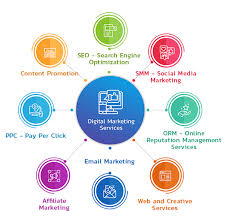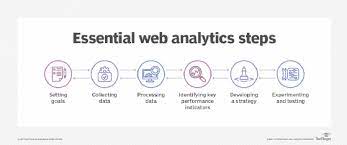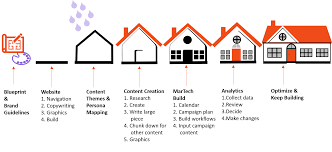The Power of an Online Marketing Dashboard: Streamlining Your Digital Strategy
In today’s fast-paced digital landscape, businesses are constantly seeking ways to optimize their online marketing efforts. With the vast amount of data and metrics available, it can be overwhelming to keep track of performance across various platforms. This is where an online marketing dashboard comes into play, offering a centralized hub for monitoring and analyzing key metrics in real-time.
An online marketing dashboard is a powerful tool that provides a comprehensive overview of your digital marketing activities. It brings together data from multiple sources, such as social media platforms, website analytics, email campaigns, and advertising channels, into one convenient location. This consolidated view allows marketers to gain valuable insights into their campaigns’ performance and make data-driven decisions.
One of the primary benefits of using an online marketing dashboard is the ability to save time and effort. Instead of manually gathering data from different sources and creating reports, marketers can access all the necessary information with just a few clicks. This streamlines the reporting process and frees up valuable time that can be better spent on strategizing and optimizing campaigns.
Furthermore, an online marketing dashboard provides real-time data updates. This means that marketers no longer have to wait for periodic reports or rely on outdated information. They can monitor key metrics such as website traffic, conversion rates, social media engagement, and advertising performance in real-time. This enables them to identify trends or issues promptly and take immediate action to capitalize on opportunities or rectify problems.
The visual nature of an online marketing dashboard also enhances data interpretation. With intuitive charts, graphs, and visualizations, marketers can easily grasp complex information at a glance. Whether it’s monitoring campaign performance over time or comparing different metrics side by side, these visuals provide a clear understanding of how each element contributes to overall success.
Another advantage of using an online marketing dashboard is its ability to facilitate collaboration among team members. By granting access to relevant stakeholders within your organization, everyone can stay on the same page and align their efforts towards common goals. This promotes transparency, encourages data-driven decision-making, and fosters a collaborative work environment.
In addition to monitoring and analyzing data, an online marketing dashboard can also help automate certain tasks. For instance, it can generate automated reports that are sent to key stakeholders at predefined intervals. This eliminates the need for manual report generation and ensures that everyone is consistently updated on campaign performance.
In conclusion, an online marketing dashboard is a valuable asset for any business looking to optimize its digital strategy. By providing a centralized hub for monitoring and analyzing key metrics in real-time, it empowers marketers to make data-driven decisions and streamline their efforts. With time-saving features, real-time updates, visualizations, collaboration capabilities, and task automation, an online marketing dashboard is a game-changer in today’s competitive digital landscape. Embrace the power of data and take your online marketing efforts to new heights with an online marketing dashboard.
Common Questions About Online Marketing Dashboards Answered
- What is a digital dashboard example?
- What should be on a marketing dashboard?
- What are the three essential elements of a marketing dashboard?
- What is a dashboard in digital marketing?
What is a digital dashboard example?
A digital dashboard is a visual representation of data that provides an overview of key metrics and performance indicators in a user-friendly format. Here is an example of a digital dashboard:
Let’s say you are managing an e-commerce website. Your digital dashboard may include the following components:
- Website Traffic: This section displays the number of visitors to your website over a specific period. It may show daily, weekly, or monthly traffic trends, as well as the percentage change compared to the previous period.
- Conversion Rate: This metric indicates the percentage of website visitors who take a desired action, such as making a purchase or signing up for a newsletter. The conversion rate section of your dashboard shows how effectively your website is converting visitors into customers.
- Sales Performance: This component provides an overview of your sales performance, including total revenue generated, average order value, and number of orders placed. It may also include visualizations such as line graphs or bar charts to illustrate sales trends over time.
- Social Media Engagement: If you have active social media accounts for your business, this section can display key metrics related to social media engagement. It may include the number of followers, likes, shares, comments, and reach across different platforms like Facebook, Instagram, Twitter, etc.
- Advertising Campaigns: If you are running online advertising campaigns (e.g., Google Ads or Facebook Ads), this section can show key metrics related to campaign performance. It may include impressions, click-through rates (CTR), cost per click (CPC), and return on ad spend (ROAS).
- Customer Support Metrics: This component focuses on customer support-related metrics such as response time to customer inquiries or average resolution time for support tickets. It helps you monitor and improve customer service efficiency.
- Email Marketing Campaigns: If you run email marketing campaigns, this section can display key metrics like open rates, click-through rates (CTR), and conversion rates for your email campaigns. It helps you evaluate the effectiveness of your email marketing efforts.
These are just a few examples of what a digital dashboard can include. The specific metrics and components will vary depending on the nature of your business and the goals you want to track. The purpose of a digital dashboard is to provide a centralized view of essential data, allowing you to monitor performance, identify trends, and make informed decisions to optimize your business strategies.
What should be on a marketing dashboard?
A marketing dashboard should include key metrics and data that provide a comprehensive overview of your marketing efforts. While the specific elements may vary depending on your business goals and strategies, here are some essential components to consider:
- Website Traffic: Monitor the number of visitors to your website, as well as the sources (organic search, social media, referrals, etc.) driving the traffic. This metric helps you understand the effectiveness of your online presence and identify areas for improvement.
- Conversion Rates: Track the rate at which website visitors convert into leads or customers. This metric provides insights into the effectiveness of your marketing campaigns and helps you identify opportunities to optimize conversion funnels.
- Social Media Engagement: Monitor metrics such as followers, likes, shares, comments, and click-through rates on your social media platforms. This data helps you gauge audience engagement and assess the impact of your social media efforts.
- Email Marketing Performance: Include metrics like open rates, click-through rates, bounce rates, and unsubscribe rates for your email campaigns. These figures help you evaluate the effectiveness of your email marketing strategy and refine future campaigns.
- Advertising Campaigns: Track key metrics related to your paid advertising efforts such as impressions, click-through rates (CTR), conversion rates, cost per acquisition (CPA), return on ad spend (ROAS), and overall campaign performance. This information allows you to optimize ad spend and maximize ROI.
- Search Engine Optimization (SEO): Keep an eye on organic search rankings for targeted keywords, organic traffic trends over time, backlink profile growth, and other SEO-related metrics. This data helps you assess the impact of SEO efforts on website visibility and organic traffic generation.
- Content Marketing Performance: Measure metrics like blog post views, time spent on page, social shares, and lead conversions attributed to content assets (e-books, whitepapers). This data provides insights into content engagement levels and helps inform content strategy decisions.
- Sales Funnel Analysis: Analyze the progression of leads through your sales funnel, from initial contact to conversion. This helps you identify bottlenecks or areas where leads may be dropping off, enabling you to optimize your sales process.
- Customer Acquisition Cost (CAC) and Customer Lifetime Value (CLTV): Calculate the cost of acquiring a new customer and compare it to the value that customer brings over their lifetime. This metric helps you evaluate marketing efficiency and make informed decisions about customer acquisition strategies.
- Key Performance Indicators (KPIs): Define specific KPIs aligned with your business goals, such as revenue growth, customer retention rate, or social media engagement rate. These KPIs should be prominently displayed on your marketing dashboard to provide a clear snapshot of overall performance.
Remember, the metrics included in your marketing dashboard should align with your business objectives and provide actionable insights for decision-making. Regularly review and update the dashboard based on evolving goals and strategies to ensure it remains a valuable tool for tracking marketing performance.
What are the three essential elements of a marketing dashboard?
When it comes to creating a marketing dashboard, there are three essential elements that should be included to ensure its effectiveness:
- Key Performance Indicators (KPIs): KPIs are crucial metrics that help measure the success of your marketing efforts. These indicators can vary depending on your specific goals and objectives, but they should align with your overall business objectives. Examples of common marketing KPIs include website traffic, conversion rates, customer acquisition cost (CAC), return on investment (ROI), social media engagement, and email open rates. Selecting the right KPIs for your dashboard will allow you to track progress and make informed decisions based on data.
- Visualizations and Data Presentation: The purpose of a marketing dashboard is to present complex data in a visually appealing and easy-to-understand format. Utilizing charts, graphs, tables, and other visual elements helps communicate information quickly and effectively. Choose visualizations that best represent the data you want to convey. For example, line graphs can show trends over time, pie charts can display the distribution of different metrics, and bar graphs can compare performance across different channels or campaigns.
- Real-time or Regularly Updated Data: To make informed decisions promptly, it’s important to have up-to-date data in your marketing dashboard. Real-time or regularly updated data ensures that you are working with the most recent information available. This allows you to identify trends, spot anomalies or issues, and react quickly if necessary. Depending on the nature of your business and the frequency of data updates, you may choose to have real-time updates or scheduled refreshes at predefined intervals.
By incorporating these three essential elements into your marketing dashboard—relevant KPIs, effective visualizations, and real-time or regularly updated data—you can create a powerful tool that provides valuable insights into your marketing performance. Remember to customize your dashboard based on your specific business needs and goals for optimal results.
What is a dashboard in digital marketing?
A dashboard in digital marketing is a visual representation of key performance indicators (KPIs) and metrics that provide an overview of a company’s online marketing activities. It is a centralized hub that consolidates data from various sources, such as website analytics, social media platforms, email campaigns, advertising channels, and more.
Digital marketing dashboards offer marketers a comprehensive view of their campaigns’ performance in real-time. They display data in an easy-to-understand format, typically through charts, graphs, and other visualizations. By presenting information in this manner, dashboards enable marketers to quickly assess the effectiveness of their strategies and make data-driven decisions.
The specific metrics included in a digital marketing dashboard can vary depending on the goals and objectives of the business. Common metrics often featured include website traffic, conversion rates, click-through rates (CTRs), engagement on social media platforms (likes, shares, comments), email open rates, cost per acquisition (CPA), return on investment (ROI), and more.
Digital marketing dashboards provide several benefits to marketers. Firstly, they save time and effort by eliminating the need to manually gather data from multiple sources or create reports from scratch. Marketers can access all the necessary information in one place with just a few clicks.
Secondly, dashboards offer real-time updates on campaign performance. Instead of waiting for periodic reports or relying on outdated information, marketers can monitor KPIs as they happen. This allows them to identify trends or issues promptly and take immediate action when needed.
Moreover, the visual nature of digital marketing dashboards makes it easier for marketers to interpret complex data quickly. Visualizations such as line graphs, bar charts, pie charts help convey information at a glance and facilitate better understanding of campaign performance.
Additionally, digital marketing dashboards promote collaboration among team members by providing access to relevant stakeholders within an organization. This fosters transparency and enables everyone to align their efforts towards common goals based on shared data.
Overall, a digital marketing dashboard is a powerful tool that helps marketers streamline their efforts, make informed decisions, and optimize their online marketing strategies. By providing a centralized view of key metrics and KPIs, dashboards empower marketers to track performance effectively and drive success in the dynamic digital landscape.




